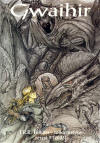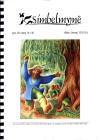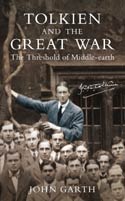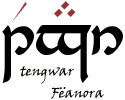![]()
![]()
[February 7, 2005]
|
Carl F. Hostetter has recently written at Lambengolmor:
"I am pleased to announce that Vinyar Tengwar 47 will be published later this month. VT 47 presents the first half of "Eldarin Hands, Fingers & Numerals and Related Writings", a four-part collection of late texts (c. 1968) by J.R.R. Tolkien, compiled and edited by Patrick H. Wynne. Part I presents Eldarin Hands, Fingers & Numerals (HFN) proper, an unfinished "historical-philological" essay that provides an account of the Common Eldarin words for 'hand' and their descendants in Quenya, Telerin, and Sindarin, followed by a brief discussion of Elvish ambidexterity. The essay then details the Eldarin names for the fingers (and toes), including children’s "play-names" that treat the fingers as the members of an imaginary family: father, mother, and children; and it concludes by showing how the finger-names were closely connected with the development of numerical stems in Common Eldarin. Included after HFN is a related text on the invention of the Common Eldarin stems for neter 9, kanat 4, and enek 6, which serves as a sort of alternative ending for the essay. Both of these texts are supplemented in the editorial notes by extensive citations drawn from Tolkien’s contemporary unpublished writings. Parts II IV (the contents of which are described in the Introduction to HFN) will appear in Vinyar Tengwar 48.
Quenya and Sindarin names of the part of the hand (information from Vinyar Tengwar 47)
|
![]()
Quenya: The Influence
of the Greek Language
An essay by Andreas Andreou
[February 7, 2005]
|
Andreas Andreou from Cyprus has written an essay about the influence of Classical Greek on Quenya for the Gwaith-i-Phethdain. It can be found in our essay department as a PDF document. It is the second and revised version of the essay.
|
![]()
[November 6, 2004]
|
Title: A Gateway to Sindarin Author: David Salo Publisher: The University of Utah Press Pages: 550 (6 x 9) ISBN: 0-87480-800-6
David Salo's book A Gateway to Sindarin. A Grammar of an Elvish Language from J. R. R. Tolkien's Lord of the Rings has been finally published! Here is what he has written on Elfling: The University of Utah Press has just published my Sindarin grammar, "A Gateway to Sindarin" -- my attempt to give something back to the Tolkien language community that has been (for the most part!) so patient with me. The book has no official dedication, but I would like to offer it to all the young students of Sindarin and other Elvish languages. I was eight when I started to try to piece together a coherent picture of Tolkien's languages out of the bits and scraps that were published in his books. I was twenty-seven when I took the bits of data I had accumulated and began to rough out the outline of a book. The book has been in manuscript for many years now, but has been continually updated and improved. The current version in hardcover represents one stage in the development of this book. It is not intended to be the last word on Sindarin; it would be impossible to create a book like this that was error-free. It is intended to be improved, criticized, rebutted, refuted, superseded - but, by putting a whole lot of information about Sindarin in one place, it is also intended to allow that criticism to take a useful form, building on whatever is useful in its foundations rather than destroying them. But until there is a new and better synthesis that can be easily found, there will be "A Gateway to Sindarin"."A Gateway to Sindarin" covers the internal history of the language, its grammar, phonology, morphology, modes of word formation, syntax, and vocabulary, with an especial emphasis on the etymologies of words and names and the phonological development of the language through time. There's also a table of specialized terms in the back to help out the non-linguist. Even if you don't need or want to learn the language in depth, but just want to find out the meaning of one of Túrin's many names, or how to interpret one of Gandalf's Sindarin spells, or how to write and pronounce "Galadriel", there is something in this book for you.
|
![]()
Parma Eldalamberon XV soon to be published!
Sí quente Fëanor and Other Elvish Writings
[September 21, 2004]
|
SÍ QENTE FEANOR is a
prose excerpt written in Qenya. It was composed by Tolkien in the same
notebook that contains the tale called "The
Nauglafring" and the Gnomish Grammar. Other
writings from the Lost Tales period presented in this issue include a
list of Qenya and Gnomish "NAMES AND REQUIRED
ALTERATIONS" connected with "The Cottage of Lost
Play"; two charts laying out the sound system of
Gnomish; and various early notes on Elvish words
and names not found anywhere else. Editorial
commentary is provided on the connections of
these texts with the contemporary tales and lexicons.
And closely connected with the grammar we also present an ENGLISH-QENYA DICTIONARY which Tolkien began to compile at this time; and from about the same period a partial INDEX OF NAMES for "The Lay of the Children of Húrin". Detailed annotations and commentary on the conceptual developments are included in this edition of these texts.
|
![]()
Thorsten's Quenya Course!
[April 25, 2004; August 26, 2004]
|
Update! Thorsten has finally published the complete version of his Quenya course. The course can be downloaded from our website.
Thorsten Renk, the creator of our Sindarin and Quenya courses has opened his own website - Parma Tyelpelassiva ('Book of Silver Leaves'). This is the index page of all Thorsen's linguistic work. There are translations of the Sindarin course in Spanish and Portugese. It also contains the grammar essays and links to their translations. A very interesting website! Thorsten wants to present his Quenya Course - Quetin i lambe eldaiva Part 1 in English. You will find there 12 lessons with Quenya texts in tengwar, grammar, vocabularies and conversations! It is now available on our website. Try and enjoy, and if you have any suggestions or questions write to Thorsten! |
![]()
Addenda and Corrigenda to the Etymologies
Vinyar Tengwar no. 45 and 46 published!
[April 25, 2004]
|
About VT #45:This 40-page issue features the first part (of two) of a complete Addenda and Corrigenda to the 'Etymologies' by Carl F. Hostetter and Patrick H. Wynne, detailing additions and corrections to the published work derived from an examination of the original manuscript and comparison with the published text.
About VT #46: This 36-page issue features the conclusion of the two-part Addenda and Corrigenda to the Etymologies by Carl F. Hostetter and Patrick H. Wynne, detailing additions and corrections to the published work derived from an examination of the original manuscript and comparison with the published text. To this are added three appendices: the first providing a complete list of the headword(s) of every entry in the Etymologies, in the order and unnormalized form of the manuscript; the second a presentation of two loose slips inserted by Tolkien into the manuscript; and the third an analysis by Arden R. Smith of the system of _tengwar_ exemplified in the entries. For further information on Vinyar Tengwar, including subscription information, please see: http://www.elvish.org/VT. These two issues of VT are absolute must for every Tolkienian linguist. My dream? That these corrections and additions will be incorporated into the text of The Lost Road (vol. V of HoMe). |
|
|
![]()
New essays about the earlier conceptual stages
of Tolkien's languages
[April 20, 2004]
|
Now you can read on-line very interesting essays about Tolkien's languages in their early conceptual stages: Are Goldogrin and Qenya "primitive"? by Patrick H. Wynne, The Goldogrin Past Tense and Goldogrin Pronouns by the same author. Ryszard Derdzinski has written Consonant Mutations in Conceptual Evolution of Noldorin/Sindarin Phonology which has been published for the first time on-line at our website (earlier it was published in Gwaihir #7). Publication of the early Tolkienian material in recent issues of Parma Eldalamberon shows us beauty and harmony of these predecessors of Quenya and Sindarin in LotR. |
![]()
E.L.F. Frequently Asked Questions by Carl F. Hostetter
[March 16, 2004]
|
On E.L.F website Carl F. Hostetter has published his Tolkienian Linguistics FAQ. It is a very interesting list of questions and answers which provides us with the point of view of the editors and publishers of J.R.R. Tolkien's linguistic papers. Every person interested in the languages of Middle-earth should read it!
Update. We have translated this FAQ into Polish. You can find it here.
Po polsku: Ciekawe FAQ (odpowiedzi na czesto zadawane pytania o jezyki Tolkiena) przelozone na polski przez Adaneth mozecie znalezc tutaj. |
![]()
Elendili - Polish Tolkien Forum
Fellowship of the Word-smiths Discussion Group in English!
[February 27, 2004]
|
English Speaking Friends, I have made a special English forum there too: English Speakers' Corner. We can discuss many topics. Three main are: (1) Neo-Quenya and Neo-Sindarin compositions, (2) Languages in the movie trylogy, (3) Notes about G-i-P website (bugs, errors, notes, opinions). Join and enjoy! The Forum Elendili has the English language mode (see in configuration of your profile). Here you can find instructions how to login (PDF made by Evenstar)
Shortly in Polish: Zapraszam wszystkich na nowe forum tolkienowskie Elendili, gdzie znajdziecie dzial Bractwo Kowali Slowa poswiecony jezykom Tolkiena. Patronuje mu nasza strona. |
![]()
Eight new lessons of Sindarin!
[February 11, 2004]
|
Thorsten Renk has updated his Sindarin Course. Today he presents eight new lessons covering more complicated features of Sindarin. Previous lessons have been corrected and revised. You should see it! Download the course from here (Sindarin Course Version 1.26, February 10, 2004, PDF e-book in the ZIP file - 462 KB). |
![]()
Parma Eldalamberon XIV is published!
Early Quenya and the Valmaric Script by J.R.R. Tolkien
[January 15, 2003]
|
From Christopher Gilson's announcement on Lambengolmor: "This (...) issue has three sections containing newly published writings by J. R. R. Tolkien: "Early Qenya Fragments", edited by Patrick Wynne and Christopher Gilson; "Early Qenya Grammar", edited by Carl F. Hostetter and Bill Welden; and "The Valmaric Script", edited by Arden R. Smith. Each of these has been prepared with the guidance of Christopher Tolkien and with the permission of the Tolkien Estate." Parma Eldalamberon Issue Number 14 is Currently at the Printer. The expected publication date is December 23, 2003. Advanced Orders can be made now at the cost of $25.00 per copy including postage and handling world-wide. For details see here.
|
![]()
Sindarin Course by Thorsten Renk!
[January 8, 2004]
|
Thorsten Renk, a Sindarinist from Germany has published the first complete course of Sindarin! He presents it on our website! Hannon le, Thorsten!
From Thorsten's Preface: This course was originally only a small project I made up for myself to train the material presented on the German website www.sindarin.de with additional texts and some structure in terms of lessons. It clearly got out of hand since then. As I write these lines, the second German version is out for download, as far as I can observe the course has become one of ’the’ standard documents for German Sindarin students in the web-based communtiy (before they move on to www.ardalambion.com), an exercise book is being prepared and I wrote a similar Quenya course which is now being reviewed. So — here’s the English translation.
Thorsten's work is splendid. Though some recostructions are controversial (i.e. pronouns, consonant mutations, elements of the conjugation) the course is the next big step in the research of Sindarin, the Noble Tongue. It is a very important attempt in making a summary of all we know about Sindarin at the moment.
The course can be downloaded from here (PDF e-book in the ZIP file - 287 KB). |
![]()
Didier Willis' Sindarin Dictionary updated
[December 11, 2003]
|
The long announced
Dragon Flame 2.0 has just been released! For the
reminder DF is the Sindarin dictionary as a Windows application.
See
here in the download
section. You should try this marvellous linguistic tool! |
![]()
Announcing Tengwestië, the online journal of the E.L.F.
[December 4, 2003]
|
From Carl F. Hostetter's
announcement on Lambengolmor: "Today
it is my great pleasure to announce Tengwestië, a new, online
journal of the Elvish Linguistic Fellowship:
For the first article in Tengwestië - The Past-Tense Verb in the Noldorin of the "Etymologies": A Formal Classification by Carl F. Hostetter - see here.
Vinyar Tengwar #45 is already published (see announcement)! Description of its contents will be here soon!
|
![]()
You can order Gwaihir and Simbelmynë NOW!
[November 18, 2003, updated December 4]
|
and (3) Derdzinski's In Pathless Mirkwood. Three Central European Motifs In Tolkien's Legendarium (about linguistic associations of Rübezahl-Gandalf, Mirkiwidu-Mirkwood and Radagaisus-Radagast - in Polish). Here you can see a sample page and here the contents page. For subscription see here.
Simbelmynë (#16, Winter 2003) is another magazine of our society. This issue has summary in English. It contains many articles about Tolkienian linguistics, eg. the first part of Derdzinski's An Introduction to Sindarin (in Polish). For subscription write to me.
|
![]()
biography with linguistic elements
[August 28, 2003]
|
|
John Garth's Tolkien and the Great War: The Threshold of Middle-earth is due to be published on 20 October in England (by HarperCollins; see here), and 1 December in the US (by Houghton Mifflin; see here). They can be pre-ordered from Amazon.co.uk and Amazon.com.
With kind permission of John Garth I present a fragment of his letter sent to me few days ago:
"Thanks to the kindness of Christopher Tolkien, who allowed me to examine various Tolkien family papers, this will be the first truly fresh biographical treatment of JRRT since |
|
Humphrey Carpenter's biography in 1976. It tells for the first time in full the story of the TCBS, Tolkien's group of school friends, and I hope it is a fitting tribute to his fellow members GB Smith and RQ Gilson, who died in the Great War, and to Christopher Wiseman, who survived it. It also recounts Tolkien's journey on the Western Front in 1916, drawing upon many personal and military records to describe the trenches and towns he saw and the actions in which he took part. But my book contains much more about Tolkien's mythological and linguistic ideas than Carpenter's biography. I have examined the relationship between language and myth in Tolkien's thought, and tried to suggest reasons why, at this particular point in time, he realised there was a connection between the two. I have also expounded on the key technical aspects of his language construction in a way that I hope the average reader will understand and enjoy; and I have tried to sketch out the state of the mythology in 1915-16, before Tolkien began the Lost Tales, using mainly the Qenya Lexicon. I hope that these latter points will interest readers of Gwaith-i-Phethdain in particular. An Epilogue provides a careful critical appraisal of _The Book of Lost Tales_, and attempts to explain why it was never completed before its gradual transformation into _The Silmarillion_. As a Postscript to my book, I provide an essay arguing that Tolkien's mythology, from its very beginnings in 1914-15, was a reaction to the First World War, and should be read not as escapism but as a powerful counterblow against the disenchantment that afflicted whole generations as a result of the war."
[Source: private correspondence with John Garth. Published with his kind permission]
|
![]()
New Tengwar Font TTF
[August 13, 2003]
|
New tengwar font has been released by Enrombel. Version 1.2 of the font Elfica TTF has a delicate and attractive shape. The keyboard layout is exactly the same as the one used by Dan Smith. Below you can see a sample of the font.
[Source: Lambenyáre] |
![]()
Artistic website with linguistic inspirations
[August 8, 2003]
|
Lea Sheler's My Precious website is a place of wonderful artwork. Lea is a graphic artist and illustrator and her artwork is also published on our website. She is also interested in Elvish languages, especially in Sindarin. In Autumn her Fëanor's Betrayal with Sindarin inscription fully transcribed, translated and analyzed will be published in the forthcoming magazine of the Polish Tolkien Society and the Gwaith-i-Phethdain - Gwaihir (see above)
|
![]()
Vinyar Tengwar no. 45 forthcoming!
[August 1, 2003]
|
Attention please! Vinyar Tengwar no. 45 is forthcoming!!! According to Carl F. Hostetter it will feature the first part (probably of two) of a complete Addenda and Corrigenda to 'The Etymologies', detailing additions and corrections to the published work derived from an examination of the original manuscript and comparison with the published text. [Source: Lambengolmor]
|
![]()
Conference Announcement: Omentielva Minya
[May 19, 2003]
|
The First International
Conference
on J.R.R. Tolkien's Invented Languages
(Informally "Omentielva Minya", or just "Omentielva")
will take place from August 4 to 8, 2005
University of Stockholm, Stockholm, Sweden.
Chairman: Bill Welden, Papers Coordinator:
Beregond, Anders Stenström, Facility Coordinator:
Professor Nils-Lennart Johannesson Membership:
$50 through July 4, 2004, website:
www.omentielva.org [Source: Lambengolmor]
|
![]()
[May 19, 2003]
|
Carl Hostetter on the E.L.F. website has published two new items: a sample of Vinyar Tengwar #43 in PDF for download and a linguistic articles page with collection of "more significant and worthwhile analytical and descriptive articles on Tolkien's invented languages found around the web."
|
![]()
Lambenyáre - linguistic informations in Spanish
[March 16, 2003]
|
El Instituto Lingüístico Lambenor (ILL) has created
the new Tolkienian linguistic information service entitled
Lambenyáre. You can find there the news from all over the world
concerned with the Tolkienian linguistics. The editors of this service
are
Josu Gómez, Elena Líria (both from the Spanish Tolkien Society)
and Héctor |
![]()
Quenya Couse revised
[March 4, 2003; updated on March 16, 2003]
|
Helge K. Fauskanger, webmaster of Ardalambion, has uploaded a revised version of his Quenya Course.
Helge has
also added a new appendix to his course:
Historically Justified Forms Or Analogical Levelling. |
![]()
[February 26, 2003]
|
|
Polish website Tengwar Fëanora ('Fëanor's Tengwar') published a review of two Polish modes of the Tengwar with examples: one by Ryszard Derdzinski (as published in Polish translation of The Lord of the Rings, Appendix E) and another by Michał Swiatkiewicz (webmaster of Tengwar Fëanora). The comparison can be found here. |
|
In Polish: Polska strona Tengwar Fëanora zaprezentowala wczoraj dwa sposoby zapisu polskich glosek literami tengwar: jeden autorstwa Ryszarda Derdzinskiego (opublikowany w polskich tlumaczeniach Wladcy Pierscieni wydawnictwa Muza i Amber) i drugi autorstwa Michala Swiatkiewicza (webmastera strony Tengwar Fëanora). Porównanie tych dwóch sposobów znajdziecie tutaj. |
|
![]()
News Archive November 2001 - February 2003
News Archive May - October 2001
![]()
Now your comments, reviews and opinions can be published at the Gwaith-i-Phethdain website. Become our Elvish Reporter! Write to me and your news will be published in the Elvish Linguistic News! Help us our service was up-to-date!
![]()
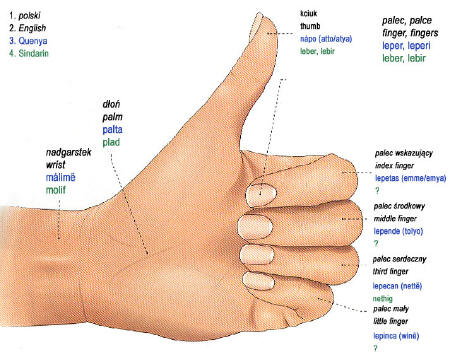
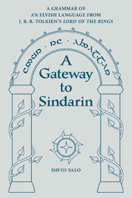
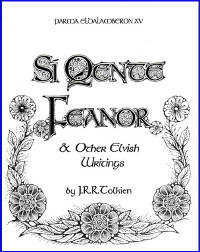

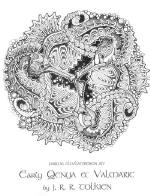 New
issue of Parma Eldalamberon has already been published and sent
to the subscribers! I have received it today. In my opinion it is the
true revolution in our Q(u)enya studies! Our yesterday knowledge about
Q(u)enya was about 1% of what we know now. This issue is the absolute
must for every true Tolkien scholar! The material is so vast that I am
not able to write the review. If somebody would like to help me I will
publish his review with pleasure! The part devoted to Valmaric script is
very interesting too! And we can learn that PE #15 will contain more
material from 1920s. I hope it will be published after this issue will
be fully analyzed and comprehended by the Tolkien scholars.
New
issue of Parma Eldalamberon has already been published and sent
to the subscribers! I have received it today. In my opinion it is the
true revolution in our Q(u)enya studies! Our yesterday knowledge about
Q(u)enya was about 1% of what we know now. This issue is the absolute
must for every true Tolkien scholar! The material is so vast that I am
not able to write the review. If somebody would like to help me I will
publish his review with pleasure! The part devoted to Valmaric script is
very interesting too! And we can learn that PE #15 will contain more
material from 1920s. I hope it will be published after this issue will
be fully analyzed and comprehended by the Tolkien scholars.
